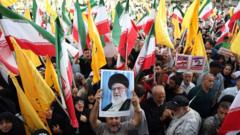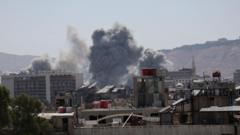Following intense military confrontations, US intervention paved the way for a fragile ceasefire between Iran and Israel, amidst escalating tensions and missile exchanges.**
Tensions Eased: The Rapid Shift Towards Ceasefire Between Iran and Israel**

Tensions Eased: The Rapid Shift Towards Ceasefire Between Iran and Israel**
A breakdown of the dramatic 24 hours that led to a ceasefire in the escalating conflict between Iran and Israel, highlighting US mediation efforts.**
In a swift and tumultuous series of events, the ongoing conflict between Iran and Israel saw a significant shift towards a tentative ceasefire, following nearly two weeks of escalated hostilities. The escalation began on June 13, when Israel intensified attacks on Iranian military installations, prompting retaliatory missile strikes from Iran.
On a particularly volatile day, marked by rapid developments, the situation took a dramatic turn. Starting early on a Monday, US officials began receiving credible intelligence of a looming Iranian missile strike targeting the al-Udeid airbase in Qatar, where thousands of US troops are stationed. The US government quickly advised American citizens in the region to "shelter in place," indicative of the grave threat posed by rising tensions.
As the military standoff escalated, Iran's Supreme Leader Ayatollah Ali Khamenei reportedly ordered strikes against US forces, stating that American military bases in the region represented vulnerabilities. The situation reached a critical point when Iranian missiles launched towards the al-Udeid base were successfully intercepted, avoiding any casualties but confirming the region's precarious balance.
By the afternoon, US President Donald Trump took to social media, commending Iran for its limited retaliation and expressing hopes for peace. His tone shifted towards diplomacy, urging both nations to embrace harmony in the region. Following frantic negotiations involving US diplomats and officials from both Iran and Israel, an official ceasefire agreement was announced.
As evening fell, reports indicated that while some attacks continued, including missile strikes from Iran towards Israel, a temporary halt appeared plausible. Trump confirmed that a ceasefire had been agreed upon and emphasized its importance, urging both countries to respect the decision.
However, as early as the following morning, alerts rang out across Israel with incoming missile threats, prompting further military responses. The situation remained tense, with each side accusing the other of breaching the ceasefire.
Despite the chaos of the situation, Trump remained adamant about maintaining the ceasefire, urging restraint from both nations. The fragile peace agreement reflects the complex dynamics of Middle Eastern geopolitics and the challenges of navigating through a region laden with historical tensions. As both nations grapple with their next moves, the world watches closely for the repercussions of this critical moment.




















